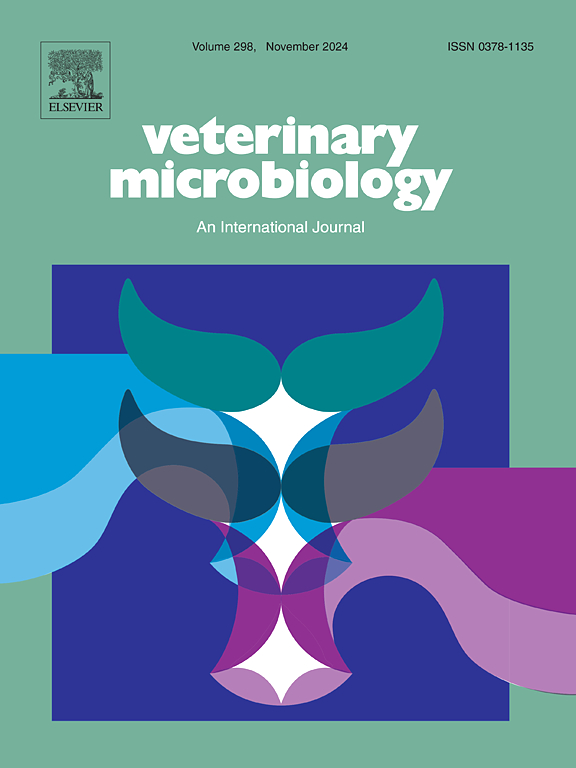肠道微生物群特征的变化与面临出血性疾病暴发的野生欧洲兔的流行病学动态相关
IF 2.7
2区 农林科学
Q3 MICROBIOLOGY
引用次数: 0
摘要
兔出血性疾病病毒(RHDV2或RHDVb)的新变种是一种致命的、新出现的传染病,在几个种类的兔中出现,并在全球范围内威胁野生兔种群。众所周知,肠道菌群在调节宿主健康,包括免疫反应和疾病易感性方面起着至关重要的作用。我们假设肠道微生物群与RHDV2爆发的流行病学动态之间存在潜在关联,这可能为了解这种致命的新兴病原体如何影响野生兔子种群提供关键见解。我们报告了在摩洛哥西北部RHD爆发之前、期间和之后,与欧洲野兔野生种群的流行病学状况相关的肠道微生物群特征的变化。在西班牙东北部一次独立的RHD暴发后,还对两个人群进行了研究。我们对每个人的肝脏、血液和新鲜的硬粪球进行取样,分别测定抗原(即RHDV RNA的存在)、抗RHDV抗体的存在以及大量16S rRNA基因分析后肠道微生物群组成的变化。相关分析和差异丰度测试揭示了不同血清学和抗原谱之间肠道微生物群的显著差异。在摩洛哥和西班牙,对拟杆菌门内的几个分类群与厚壁菌门内的几个分类群进行的B/F比值的阈值为1,将易感个体(B/F <1)和非易感个体(B/F >1)分开。幼鱼的B/F <; 1个体比例最高,幼鱼RHD死亡的100 %和成虫RHD死亡的75 %的个体B/F <; 1。尽管这种关联的确切性质仍有待确定,但这项工作显示了一个有趣的潜在发展,既可以探索RHDV2在肠道微生物群方面的生态动态,也可以开发潜在的靶向治疗或管理策略,以保护和控制害虫。本文章由计算机程序翻译,如有差异,请以英文原文为准。
Changes in gut microbiota signatures associated with the epidemiological dynamics of wild European rabbits facing haemorrhagic disease outbreaks
The new variant of rabbit haemorrhagic disease virus (RHDV2 or RHDVb) is responsible for a lethal, emerging infectious disease in several species of lagomorphs, and is globally threatening wild rabbit populations. It is known that the gut microbiota plays a crucial role in modulating host health, including immune responses and disease susceptibility. We hypothesize potential association of gut microbiota with the epidemiological dynamics of RHDV2 outbreaks that may provide key insights into how this lethal, emerging pathogen impacts wild rabbit populations. We report on changes in the gut microbiota signatures associated with the epidemiological status of a wild population of European rabbits before, during, and after an RHD outbreak in NW Morocco. Two populations were also studied in NE Spain after an independent RHD outbreak. From each individual, we sampled liver, blood, and fresh hard faecal pellets to determine the presence of antigen (i.e. presence of RHDV RNA), antibodies against RHDV, and changes in gut microbiota composition after massive 16S rRNA gene analysis, respectively. Correlational analysis and differential abundance tests were carried out to unveil significant differences in the gut microbiota among the different serological and antigen profiles. A B/F ratio based on several selected taxa within the order Bacteroidales vs. several taxa within the phylum Firmicutes showed a threshold value of 1 that split susceptible (B/F <1) and non-susceptible individuals (B/F >1) both in Morocco and in Spain. The highest proportion of individuals B/F < 1 was found in juveniles, and 100 % of the juveniles RHD dead and 75 % of the adults RHD dead scored B/F < 1. Although the exact nature of this association remains to be determined, this work shows an interesting potential take-off to both explore RHDV2's ecological dynamics with regards to intestinal microbiota and developing potential targeted treatments or management strategies for conservation and pest control.
求助全文
通过发布文献求助,成功后即可免费获取论文全文。
去求助
来源期刊

Veterinary microbiology
农林科学-兽医学
CiteScore
5.90
自引率
6.10%
发文量
221
审稿时长
52 days
期刊介绍:
Veterinary Microbiology is concerned with microbial (bacterial, fungal, viral) diseases of domesticated vertebrate animals (livestock, companion animals, fur-bearing animals, game, poultry, fish) that supply food, other useful products or companionship. In addition, Microbial diseases of wild animals living in captivity, or as members of the feral fauna will also be considered if the infections are of interest because of their interrelation with humans (zoonoses) and/or domestic animals. Studies of antimicrobial resistance are also included, provided that the results represent a substantial advance in knowledge. Authors are strongly encouraged to read - prior to submission - the Editorials (''Scope or cope'' and ''Scope or cope II'') published previously in the journal. The Editors reserve the right to suggest submission to another journal for those papers which they feel would be more appropriate for consideration by that journal.
Original research papers of high quality and novelty on aspects of control, host response, molecular biology, pathogenesis, prevention, and treatment of microbial diseases of animals are published. Papers dealing primarily with immunology, epidemiology, molecular biology and antiviral or microbial agents will only be considered if they demonstrate a clear impact on a disease. Papers focusing solely on diagnostic techniques (such as another PCR protocol or ELISA) will not be published - focus should be on a microorganism and not on a particular technique. Papers only reporting microbial sequences, transcriptomics data, or proteomics data will not be considered unless the results represent a substantial advance in knowledge.
Drug trial papers will be considered if they have general application or significance. Papers on the identification of microorganisms will also be considered, but detailed taxonomic studies do not fall within the scope of the journal. Case reports will not be published, unless they have general application or contain novel aspects. Papers of geographically limited interest, which repeat what had been established elsewhere will not be considered. The readership of the journal is global.
 求助内容:
求助内容: 应助结果提醒方式:
应助结果提醒方式:


